When you are ready to mow your lawn mower and get everything ready, the last thing you want is to see the mower malfunctioning. You can blame the spark plug because it often creates issues and requires a replacement.
Generally, it would be best to change the spark plug every 25 hours, every season before the mowing session, or whenever your mower has trouble starting. Engine not starting, stalling between mowing, or increased gas consumption signifies a bad spark plug that needs a quick replacement.
Sometimes, understanding whether the problem is the spark plug is difficult. Read on to explore the frequency of spark plug replacement, factors affecting the frequency, common signs, and steps to replace the plug.
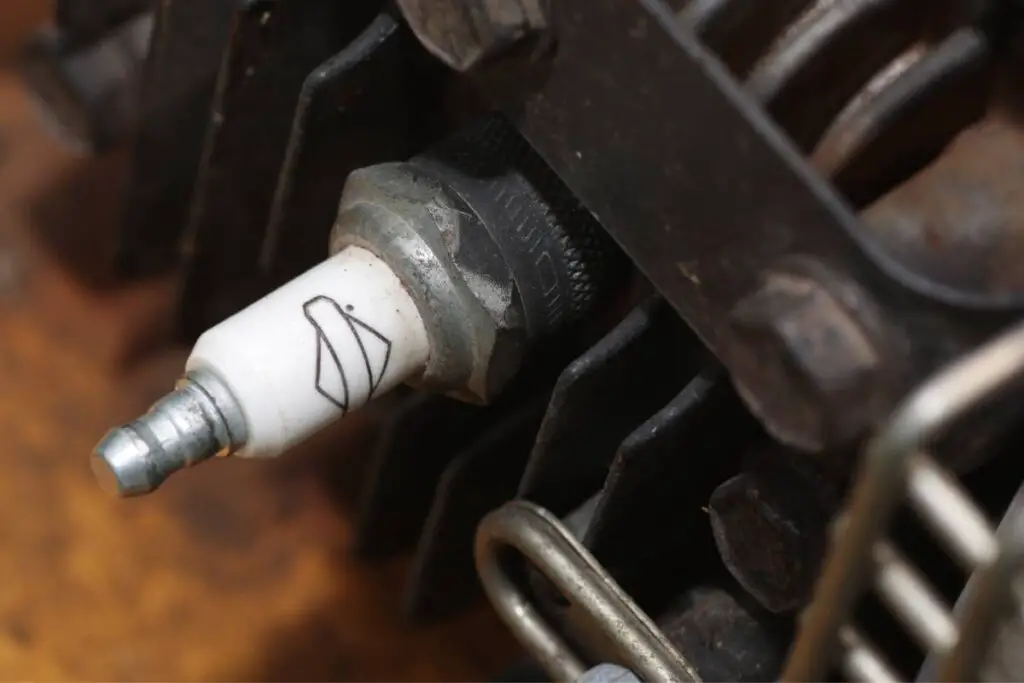
How often should you change a lawn mower’s spark plug?
Spark plugs are an important part of lawn mowers.
They help the mower to start the engine.
Spark plugs will need regular replacement and cleaning.
It does not matter how well you maintain it.
But the plugs can wear out after long and continuous use.
Generally, it lasts for 25 hours.
According to the Tractor Supply Company, or TSC, changing the lawn mower’s spark plug should be included in the yearly maintenance of the mower.
Some mower owners do it in the fall, and others do it in the spring.
Some people replace it during every mowing session.
If you use a mower for 25 hours every season, you should change them regularly to avoid spark plug issues.
Factors affecting the frequency of spark plug replacement
The replacement frequency of the spark plug is every 25 hours, but several factors affect the timing.
The main reason behind a spark plug requiring frequent replacement is the increased gap between the electrodes that wear out over time and insufficient voltage at the plug tip.
Below are a few factors that affect the frequency of the spark plug replacement in the mower.
Some of these factors are the reasons behind a spark plug going bad :
Engine type
The same engineer sometimes designs the engine and the spark plug to achieve efficient performance from both parts.
If your mower engine drives hard, it will affect the spark plug and lead to constant wear and tear.
So, you will need new spark plugs more frequently before the 25 hours are over.
Usage frequency
If you have mowed for 25 hours in one season, change the spark every new season before the mower session.
Depending on how frequently you use the mower, you may have to change it more than once in one season.
Using your mower daily for longer periods will stress your spark plug and result in premature wear and tear.
So, you have to replace it too often.
Besides, overuse can overheat the mower and the spark plug, weaken the ignition system and increase the space between the electrodes and the plug’s center.
Fuel or gasoline type

Fuel or gasoline quality can affect the spark plug and reduce its lifespan.
As a result, you will frequently change the spark plug due to premature damage.
Some materials used in the fuel won’t last long.
Once the fuel enters the engine, it contacts the spark plug and erodes it over time.
Leaded gasoline is a common fuel affecting the spark plug replacement frequency.
It adds lead into the engine, which gathers over piston rings or valves.
Over time, the lead buildup will reach and damage the spark plug.
So, you have to change the spark plug more often.
Operating conditions
Frequently turning it on and off, pulling, and using it forcibly over inclined areas can wear out the spark plugs at a high rate.
As a result, you will have to change the spark plugs more often.
Spark plug type
The spark plug material can affect the replacement frequency.
Different materials have different lifespans.
Copper is a good conductor. But a spark plug made of iridium or platinum lasts longer than copper ones.
However, since copper is a good conductor, current flows more freely through this material than the other two.
Some spark plugs are high-performance plugs.
If you have one of these, you must replace them too often.
Old lawn mower
If your mower is too old, it will develop leakage, and the gaskets, seals, and other components will wear out.
It increases gaps between the moving parts, electrodes, and the spark plug, thus resulting in frequent replacement.
Cutting wet and thick grass
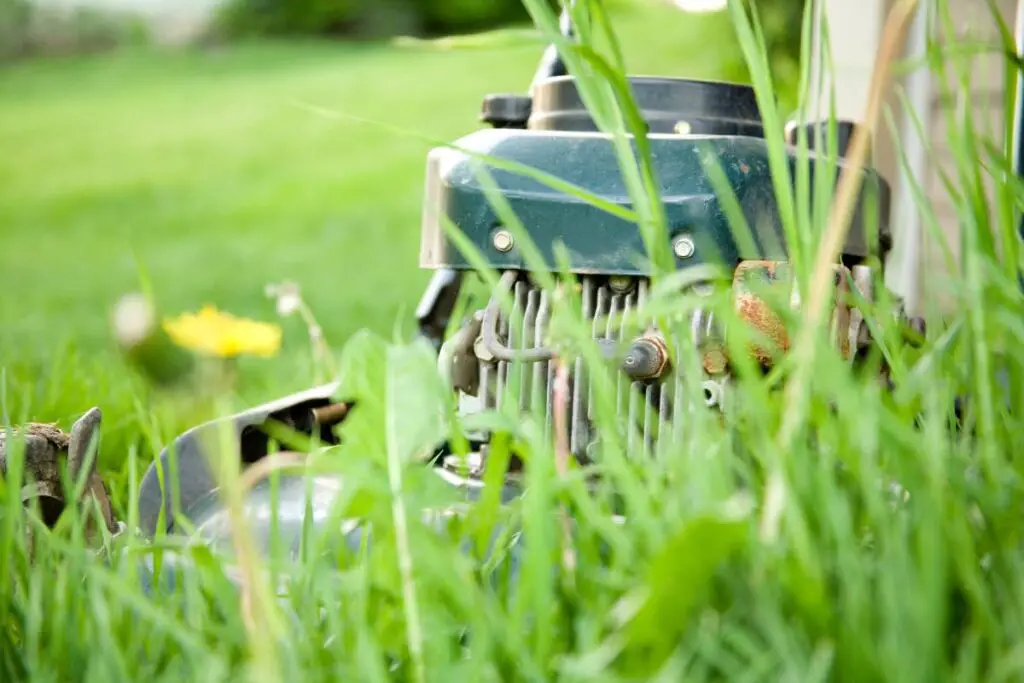
The lawn mower will work harder when you cut thick or wet grass.
As a result, the mower will overwork, use mower power, and utilize the spark plug more often.
Extreme work will wear the spark plug more often than normal and require frequent changes.
Looking for gardening supplies? We have tested 100's of products before recommending them to you guys. Check out our best pick below:
| Image | Gardening Supplies | Best Price? |
|---|---|---|
 Top
Top Top
Top | Raised Garden Bed Kit | Check On Amazon |
 | XLUX Soil Moisture Meter, Plant Water Monitor, Soil Hygrometer Sensor for Gardening, Farming, Indoor and Outdoor Plants, No Batteries Required | No Results |
 Top
Top Top
Top | 82 Pcs Garden Tools Set and Extra Succulent Tools Set | Check On Amazon |
 | Joeys Garden Expandable Garden Hose with 8 Function Hose Nozzle, Lightweight Anti-Kink Flexible Garden Hoses, Extra Strength Fabric with Double Latex Core, (50 FT, Black) | No Results |
 Top
Top Top
Top | Dual Chamber Compost Tumbler | Check On Amazon |
 Top
Top Top
Top | Sunnyglade Plant Stakes | Check On Amazon |
 Top
Top Top
Top | Organic Cold Pressed Neem Seed Oil | Check On Amazon |
 Top
Top Top
Top | Mighty Mint Gallon :-Insect and Pest Control Peppermint Oil | Check On Amazon |
 Top
Top Top
Top | Scotts DiseaseEx Lawn Fungicide | Check On Amazon |
 Top
Top Top
Top | Jacks Classic 20-20-20 All Purpose Fertilizer | Check On Amazon |
 Top
Top Top
Top | 30,000 Seeds Pollinator Attracting Wildflower Mixture | Check On Amazon |
 Top
Top Top
Top | Survival Vegetable Seeds Garden Kit-Over 16,000 Seeds | Check On Amazon |
Overheating
Overheating can occur for several reasons, faulty cooling systems being common.
Overheating the mower will affect the spark plug and cause premature wear and tear.
Repeated overheating will wear down the electrodes and strain the spark, thus damaging the plug faster than normal.
Due to overheating, you have to change the spark plug too often.
Oil in the combustion chamber
Seals can wear out over time and leak into the chamber near the spark plug.
Oil can foul the spark plug’s tip, damage it, and shorten its lifespan, thus increasing the replacement frequency.
The spark plug is to blame when you find out that the mower is burning too much oil.
Carbon buildup
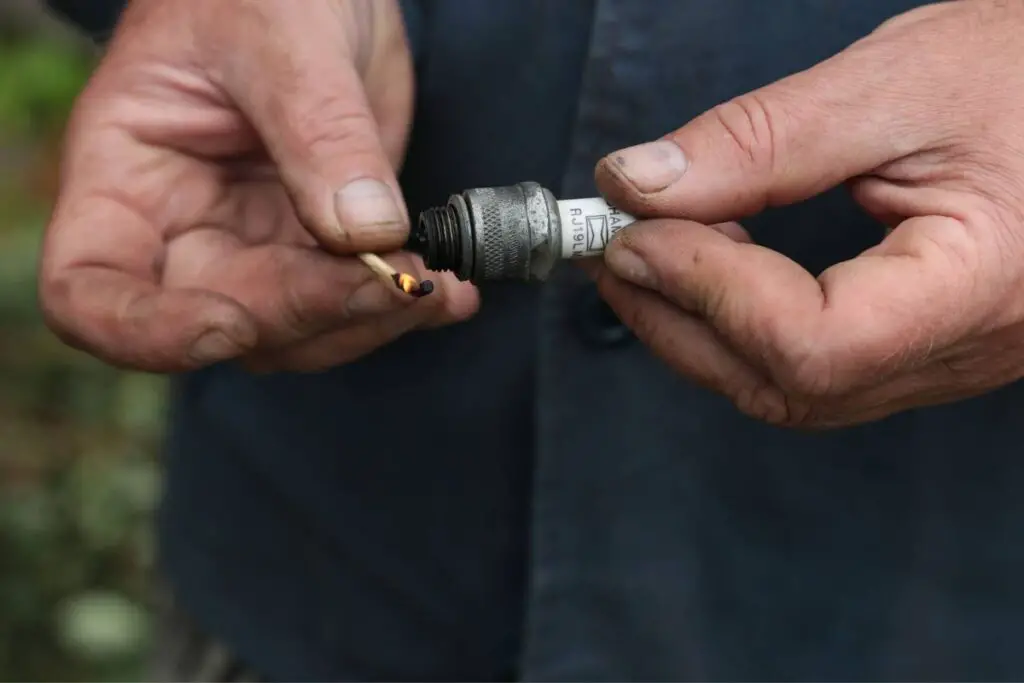
It is carbon buildup when you remove the spark plug and find it black.
The buildup happens due to the dirt and debris entering the area where the plug will ignite.
The buildup will weaken the spark plug and make it less effective.
Changing the plug is the only way out. Such a situation will increase the replacement frequency.
Rough handling damages the electrodes
The structural integrity of the spark plug is very important for its smooth functioning.
If any part of the plug, especially the porcelain part, is scratched, chipped off, cracked, or worn out, the spark plug will not function and will need a replacement.
It occurs due to the rough handling of the spark plug and the mower.
Signs signifying a bad spark plug
When a spark plug goes bad, it will display several warning signs to tell you it needs replacement.
If you are unaware of these signs, here are a few of them to help you identify them:
1. Engine misfire
Engine misfiring is one of the serious signs signifying a damaged spark plug.
Due to a bad spark plug, the fuel burns insufficiently.
The catalytic conversion will damage due to the unburned fuel and leaks from the mower.
2. Decreased engine performance
With a bad spark plug, if your engine manages to start, it will die out immediately after some time.
Sometimes, the engine will stop in the middle of the mowing.
Every time the engine dies, you can restart it. But it further overheats the machine and reduces its lifespan.
Overheating can increase the gap between the plug’s center and firing electrodes and weaken the ignition spark.
3. Hard starting
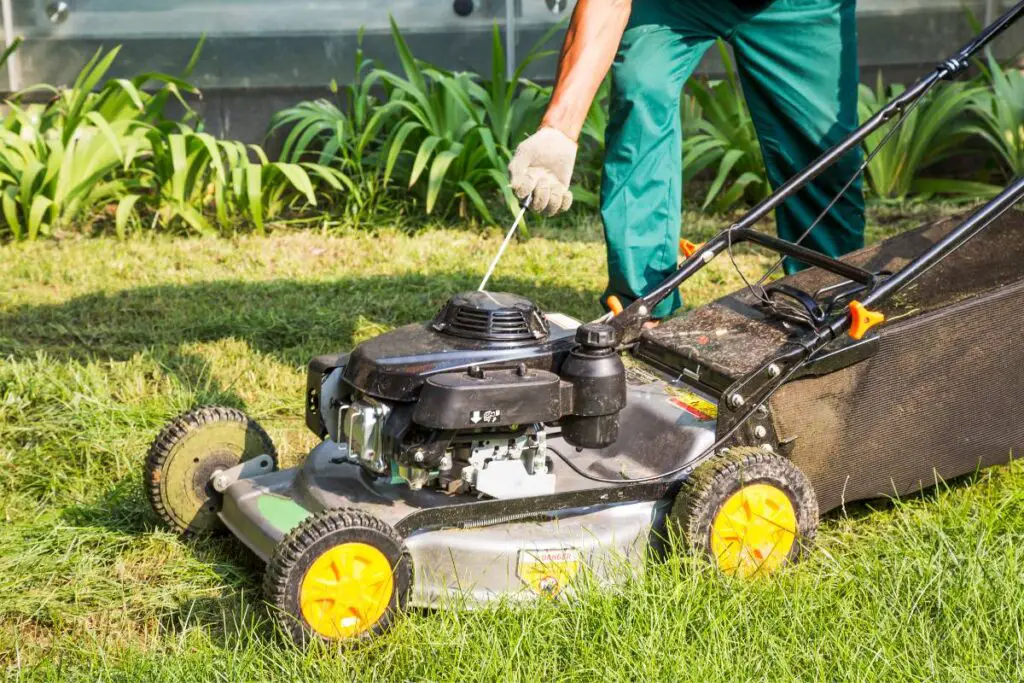
A bad spark plug will make the mower difficult to start at the beginning.
A push mower will take several pulls to start.
A tracker mower will fail to start at the first few key turns.
Due to the bad spark, the spark it makes won’t be strong enough to ignite the fuel and air mixture delivered by the carburetor.
4. Spark plug fouling
Your lawn mower’s spark plug will foul if it is in bad shape.
Due to a fouled spark park, there won’t be any sparks or combustion.
5. Engine not starting
The lawn mower’s spark plug connects to the wire that starts the ignition system.
If the spark plug goes bad, the lawn mower engine will not start again.
It will take some time to start in the beginning. Over time, the mower will suddenly turn off one day and won’t start again.
6. Excessive fuel consumption
With a bad spark plug, you have to refill the gasoline tank more often than normal during or between the mowing sessions.
The gasoline cannot burn completely or inefficiently due to the poor spark plug. As a result, fuel consumption increases, and efficiency decreases.
Since the fuel cannot burn properly, poor firing will lead to a raw gasoline smell from the mower during operation.
How to replace a lawn mower’s spark plug?
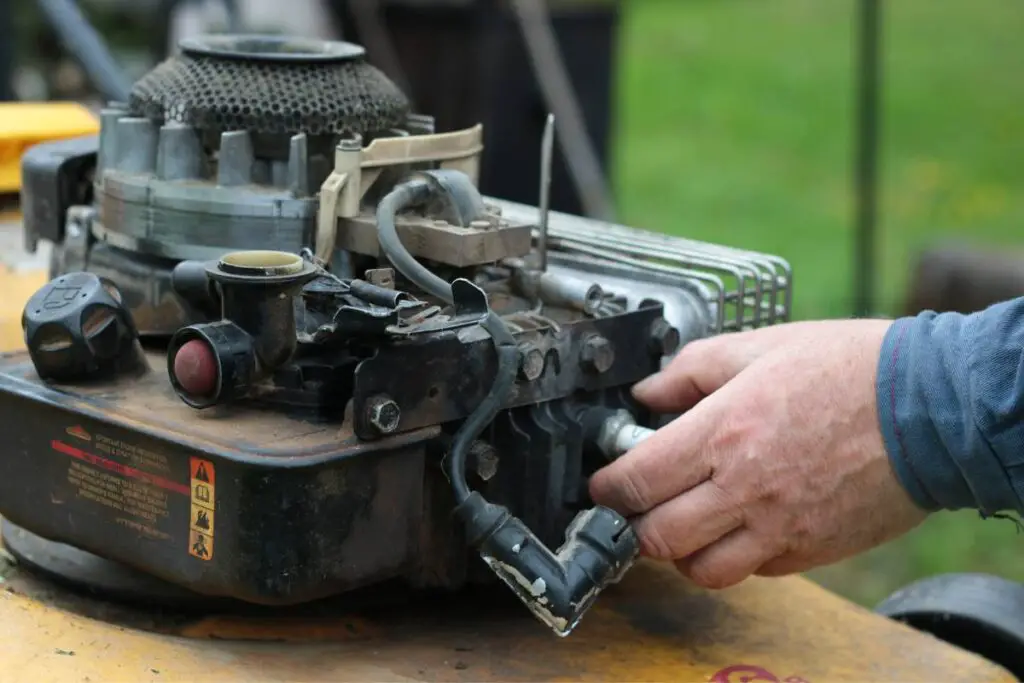
Changing a lawn mower spark plug is relatively easy if you know the right steps.
Sometimes, you do not need to change if your mower has not worn out that much but only malfunctions a bit. Cleaning will do the work.
However, if you need to replace it, here are the steps:
Step 1: Get a new spark plug
Buy a new spark plug for your mower to replace the old one.
Spark plug sizes are not universal. So, make sure you choose the right one for your mower by consulting the owner’s manual.
The incorrect spark plug will lead to the following:
- The spark plug is not screwing in properly
- Engine is misfiring
- The engine is not starting or being rough while running
- Oil leaking at the tips and threads of the plug
- The plug is failing and overheating frequently
Step 2: Disconnect the spark plug lead
The spark plug lead is a flexible rubber around the ceramic end with a metal contact.
Pull the rubber out carefully from the plug with some wiggling back and forth.
Step 3: Use a socket to remove the plug
You will need a socket to remove the spark plug.
The socket is developed to remove the spark plug without damaging it.
Slide the socket over the spark plug and turn it counterclockwise.
If it is too tight, apply WD-40 or some lubricant and wait until it becomes loose and easier to remove.
Step 4: Check the spark properly
After removing the spark plug, inspect it closely to find the damage level.
A damaged spark plug will look black, worn-out, oily, and cracked ceramic coating.
Step 5: Install the new plug
Remove the old plug and install the new spark plug.
Put the plugin by turning it with your hand or socket first to prevent cross-thread.
If you cannot turn it by hand, use a wrench or socket to secure it.
Step 6: Reconnect
Reconnect the spark plug wire, and the plug lead back.
Make sure to tighten everything properly and turn on your mower for testing.
Best practices for changing spark plug
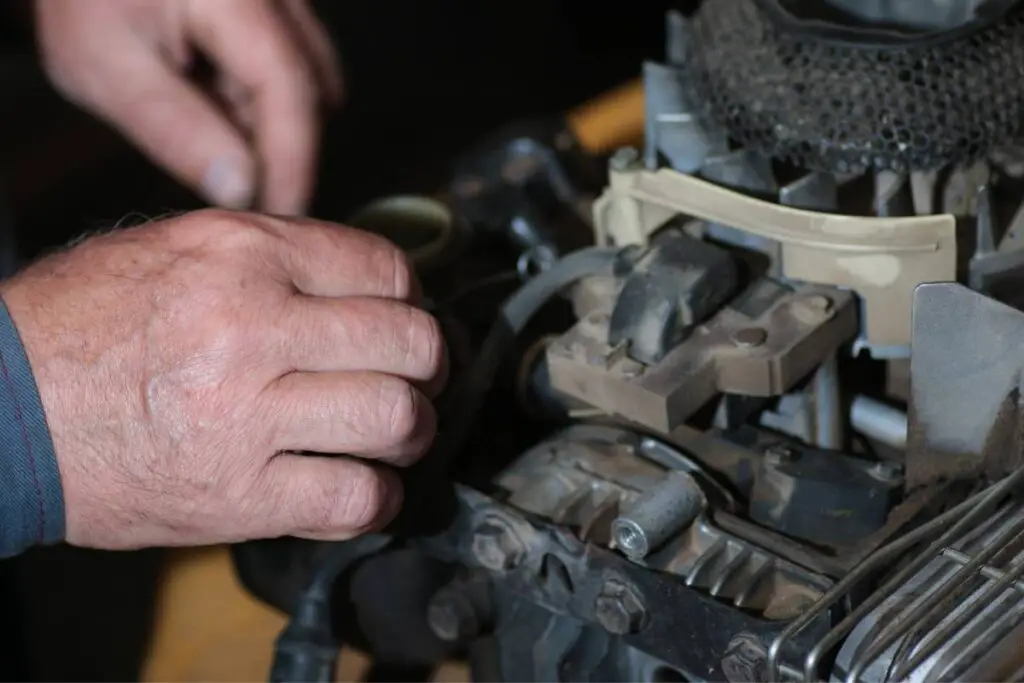
While replacing a spark plug, consider performing a few steps and making them a regular habit.
Executing these practices will avoid further issues and keep your mower safe in the long run.
Cleaning and replacing the air filters
Change or clean the air filters whenever you clean or replace the spark plug.
These filters can accumulate dirt over time.
Changing them can improve air circulation and prevent various other issues.
To clean or replace the filters:
- Remove the filter attached with knobs and wire nuts.
- Remove the leftover dirt carefully without dropping them in the air intake.
- Tap your fingers against the solid surface to loosen the dirt and throw them out.
- Check your filter closely. If you have a paper filter, lift it and try seeing through it. For foam filters, check for tear and brittleness.
- If the filters are too dirty, replace them with a new ones and reattach the housing.
- If you have foam filters, wash with soap water, dry and saturate them with oil and reattach them back.
Checking the spark plug gap
Before installing the spark plug to your mower engine, check and measure the gap.
Gather a feeler gauge or spark plug gap tool, the owner’s manual, and the mower’s model number.
Find the recommended gap in the manual, measure it, and adjust it to the width mentioned.
The standard gap should be between 0.02 and 0.035 inches.
If the gap is imperfect, adjust it properly with a feeler gauge, wire gap tool, or coin gap tool by gently bending the grounded electrode wide or narrow.
After adjusting, take another measurement to confirm it.
Using the recommended spark plug
Use a spark plug recommended by the manufacturer or the one mentioned in the owner’s manual.
The wrong size will lead to issues like:
- The spark is plug not screwing in properly
- Engine misfiring
- The engine is not starting
- Oil at the tips and threads of the plug
- The plug is failing
While buying the spark plug, consider 3 main features:
- Thread size
- Thread length
- Heat rating
A small guide to spark plugs for mowers:
Push mower
- Pitch: 1-1.5 mm
- Diameter: 10-12 mm
- Reach 9-12 mm
Riding mower
- Pitch: 1-1.5 mm
- Diameter: 12-14 mm
- Reach: 15-19 mm
Proper tightening of the spark plug
After you attach the spark plug in its place with the socket, you should properly tighten the plug to avoid any loose connections.
Also, do not tighten the spark plug too much. Excessive tightening will damage the spark plug and make it difficult to open during the replacement.
Final thoughts
If the mower’s spark plug is the main problem, you are fortunate because cleaning and replacing the spark plug is easy. One simple fix can solve multiple issues at once. Generally, it would be best to change the spark plug every 25 hours, but it depends.
The replacement frequency is affected by engine and fuel type, usage frequency, engine type, the machine age, spark plug type, and operating conditions. Other factors include overheating, cutting wet grass, oil leakage, carbon buildup, and rough handling of the spark plug.
You can identify a bad spark plug from signs like engine misfire, spark plug fouling, engine stopping between mowing or not starting, and increased fuel consumption.
When you watch such signs, check the spark plug’s condition and replace it with a new one. Perform the best practices to keep your mower in good shape in the long run.
Generally, it lasts for 25 hours. But certain circumstances, like overheating, oil leakage, or cutting wet and thick grass, can reduce the mower’s lifespan.
Why is the spark plug gapping necessary?
Maintaining a slight gap between the center and side electrodes helps to create the spark that helps ignite the fuel and start the combustion in your lawn mower’s engine.
How long does a lawn mower last?
Generally, it lasts for 25 hours. But certain circumstances, like overheating, oil leakage, or cutting wet and thick grass, can reduce the mower’s lifespan.
